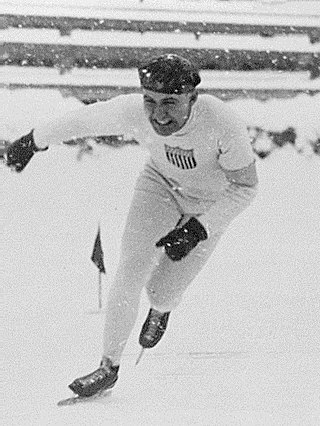
Speed skating is a competitive form of ice skating in which the competitors race each other in travelling a certain distance on skates. Types of speed skating are long-track speed skating, short-track speed skating, and marathon speed skating. In the Olympic Games, long-track speed skating is usually referred to as just "speed skating", while short-track speed skating is known as "short track". The International Skating Union (ISU), the governing body of competitive ice sports, refers to long track as "speed skating" and short track as "short track skating". Long track speed skating takes place on a 400m ice track, while short track takes place on a 111m track.

The 1928 Winter Olympics, officially known as the II Olympic Winter Games and commonly known as St. Moritz 1928, were an international winter multi-sport event that was celebrated from 11 to 19 February 1928 in St. Moritz, Switzerland.

The 1924 Winter Olympics, officially known as the I Olympic Winter Games and commonly known as Chamonix 1924, were a winter multi-sport event which was held in 1924 in Chamonix, France. Originally held in association with the 1924 Summer Olympics, the sports competitions were held at the foot of Mont Blanc in Chamonix, and Haute-Savoie, France between 25 January and 5 February 1924. The Games were organized by the French Olympic Committee, and were originally reckoned as the "International Winter Sports Week". With the success of the event, it was retroactively designated by the International Olympic Committee (IOC) as "the first Olympic Winter Games".
1924 in sports describes the year's events in world sport.

The 1924 Winter Olympics, officially known as the I Olympic Winter Games, and known at the time as Semaine Internationale des Sports d'Hiver, was a winter multi-sport event held in Chamonix, France, from 25 January to 5 February 1924. Norway topped the table, collecting seventeen medals in total, including four gold, three of which were won by Thorleif Haug in the Nordic combined and cross-country skiing events. Norway also achieved two podium sweeps, winning all three medals in both the 50 km cross-country skiing and the Nordic combined. This remained a record at the Winter Olympics until 2014.
At the 1924 Winter Olympics in Chamonix, five speed skating events were contested, all for men. The competitions were held on Saturday, January 26, 1924, and on Sunday, January 27, 1924. Charles Jewtraw won the first gold medal of the 1924 Winter Games, and Clas Thunberg and Roald Larsen each won medals in all five events, with Thunberg winning 3 gold.

Long-track speed skating, usually simply referred to as speed skating, is the Olympic discipline of speed skating where competitors are timed while crossing a set distance. It is also a sport for leisure. Sports such as ice skating marathon, short-track speedskating, inline speedskating, and quad speed skating are also called speed skating.

Arnold Clas ("Classe") Robert Thunberg was a Finnish speed skater who won five Olympic gold medals – three at the inaugural Winter Olympics held in Chamonix in 1924 and two at the 1928 Winter Olympics held in St. Moritz. He was the most successful athlete at both of these Winter Olympics, sharing the honour for 1928 Winter Olympics with Johan Grøttumsbraaten of Norway. No other athlete ever won such a high fraction of all Olympic events at a single Games. He was born and died in Helsinki.

John O'Neil Farrell was an American speed skater and speed skating coach.

Finland competed at the 1924 Winter Olympics in Chamonix, France. Finnish athletes won a total of 11 medals. The majority of these were awarded in speed skating, to Clas Thunberg and Julius Skutnabb.
Roald Morel Larsen was a World Champion speed skater from Norway. He was born in Kristiania . Roald Larsen's parents were Hans Jacob Larsen, a glazier born in Kristiania in 1870, and Lydia Larsen, born in Porsgrunn in 1865. They had four children, all sons: Jaan Harald (1891), Lyder Ragnar (1895), Roald Morel (1898), and Gelgjermo Stone (1899).
The 1500 metres speed skating event was part of the speed skating at the 1924 Winter Olympics programme. The competition was held on Sunday, January 27, 1924. Twenty-seven speed skaters from ten nations were due to compete, but five athletes withdrew, so in the end twenty-two speed skaters from nine nations competed. The Finnish athlete Asser Wallenius fell and did not finish the race.
The 5000 metres speed skating event was part of the speed skating at the 1924 Winter Olympics programme. The competition was held on Saturday, January 26, 1924. Thirty-one speed skaters from thirteen nations were due to compete, but nine athletes withdrew, so in the end twenty-two speed skaters from ten nations competed. The Canadian athlete Charles Gorman abandoned the race after the first round.
The 10,000 metres speed skating event was part of the speed skating at the 1924 Winter Olympics programme. The competition was held on Sunday, January 27, 1924. Twenty-one speed skaters from nine nations were due to compete, but five athletes withdrew, so in the end sixteen speed skaters from six nations competed. The French athlete George de Wilde abandoned the race.
The 500 metres speed skating event was part of the speed skating at the 1928 Winter Olympics programme. The competition was held on Monday, 13 February 1928. Thirty-three speed skaters from 14 nations competed.
The 1500 metres speed skating event was part of the speed skating at the 1960 Winter Olympics programme. The competition was held on the Squaw Valley Olympic Skating Rink and for the first time at the Olympics on artificially frozen ice. It was held on Friday, February 26, 1960. Forty-eight speed skaters from 16 nations competed.

Christfried Burmeister was an Estonian speed skater and bandy player who competed in the 1928 Winter Olympics.










